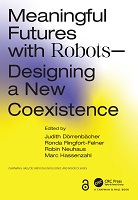Chapter 3 How to Design Robots with Superpowers
Proposal review
Author(s)
Neuhaus, Robin
Ringfort-Felner, Ronda
Dörrenbächer, Judith
Hassenzahl, Marc
Language
EnglishAbstract
Robots are often designed to increase efficiency. They are typically positioned in a particular field of application to replace humans, making someone’s work obsolete. But robots are able to complement the humans they work with through collaboration and the incorporation of the psychological strengths that robots can have in social situations. This chapter presents a co-design method based on a possibility-driven design approach and “robotic superpowers” (a concept that originated from Welge, Hassenzahl, Dörrenbächer and colleagues). Social robots can offer new, positive experiences and constructively impact work practices that incorporate their social strengths, such as endless patience or unbiased selection. To that end, the chapter describes a three-step design process by collecting existing work practices, defining scenario-specific robotic superpowers, and developing concepts for future robots. To illustrate possible outcomes, the authors showcase several exemplary concepts created using this new process.
Keywords
a, aI, Coexistence, Designing, Dorrenbacher, Dörrenbächer, et, Felner, Futures, Hassenzahl, Judith, Marc, Meaningful, Neuhaus, New, Ringfort, Robin, Robots, RondaDOI
10.1201/9781003287445-3ISBN
9781032262673, 9781032246482, 9781003287445Publisher
Taylor & FrancisPublisher website
https://taylorandfrancis.com/Publication date and place
2023Imprint
CRC PressClassification
Computing and Information Technology
Robotics
Human–computer interaction


 Download
Download